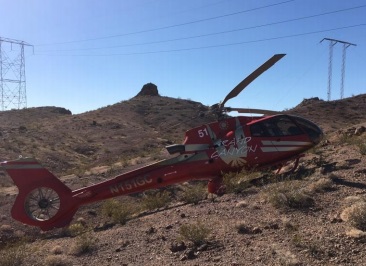Arriel Engine Failure after Inadvertently Being Put Back into Service Incomplete (Papillon, EC130B4 N151GC)
A pilot made an excellent forced landing in rising mountainous terrain, on 27 June 2017 in Airbus Helicopters EC130B4 N151GC following a loss of engine power near Boulder City, Nevada. The helicopter was being operated by Papillon Grand Canyon Helicopters on an air tour flight.
The pilot and 4 passengers were uninjured. Two other passengers sustained minor injuries. The aircraft was damaged.
Accident Flight
According to the US National Transportation Safety Board (NTSB) safety investigation report:
The pilot reported that, as he executed an “S-turn” about 3,000 ft mean sea level, the helicopter made a subtle yaw to the right, which was accompanied by an audible “gong.” The pilot lowered the collective and simultaneously noted a yellow engine parameter failure indication on the instrument display. Moments later, the main rotor rpm warning horn activated and was followed by warning lights on the caution warning display. The helicopter began to descend immediately.
The pilot elected to perform an autorotation to a nearby helicopter pad. In the attempt to steer away from power lines, the pilot made a left cyclic input; however, the retreating main rotor blade contacted a power line. The pilot continued to maneuver the helicopter and subsequently made an up-slope emergency landing on rising mountainous terrain.
Safety Investigation
The helicopter was powered by a Safran Arriel 2B1 turboshaft engine.
Postaccident on-site engine examination revealed that both the gas generator and power turbine were seized and could not be rotated by hand and that there was a significant amount of heat damage to the turbine blades and thermocouples. The vehicle and engine multifunction display recorded multiple engine temperature exceedances during the accident flight. Metal particles were found on the accessory gearbox [AGB] magnetic plug. Further, no oil filter was found installed in the airplane [sic].
The NTSB report that:
The last maintenance performed on the engine was 109.6 hours prior to the accident at the Safran HE USA facility, Grand Prairie, Texas. On June 30, 2016, the facility received the accessory gearbox for an overhaul. The oil filter was removed and discarded as part of the normal process for arrival inspection.
However:
During the document review, it was determined that the overhaul was not due, and the operator agreed to have the accessory gearbox sent back as is.
The maintenance organisation correctly shipped the AGB with a log card entry “Equipment returned repairable, not repaired, not airworthy as is” and without a serviceable tag. They reportedly did not inform the operator that they had commenced maintenance on the AGB and removed the engine oil filter.
That log card entry was subsequently voided, on the instruction of the maintenance organisation Quality Manager, “after being questioned by the operator thus reverting the airworthiness back to the previous entry”.
Although not discussed by the NTSB the implication is there was an incomplete shared-understanding of what work had been performed before the overhaul was cancelled.
The engine was rebuilt and operated for 109.6 hours without the oil filter installed this…
…led to coke pollution that obstructed the oil jet and resulted in the subsequent oil starvation of the axial compressor rear bearing oil and its subsequent failure.
Safety Resources
- Professor James Reason’s 12 Principles of Error Management
- Back to the Future: Error Management
- Safety Performance Listening and Learning – AEROSPACE March 2017
- Maintenance Human Factors: The Next Generation
- Airworthiness Matters: Next Generation Maintenance Human Factors
- Coking Causes Power Loss: Australian AS350BA
- Fire After O-Ring Nipped on Installation
- Fatal S-61N Dual Power Loss During Post Maintenance Check Flight
- UPDATE 14 February 2019: AS350B2 Accident After Vibration from Unrecorded Maintenance
- UPDATE 23 March 2019: Maintenance Misdiagnosis Precursor to Tail Rotor Control Failure
- UPDATE 17 August 2019: AS350 Tail Rotor Control Incident, Grand Caymen
- UPDATE 1 April 2019: Tree Top Autorotation for B206L1 After Loose Fuel Line B-Nut Leaks
- UPDATE 24 October 2019: EC135P2+ Loss of NR Control During N2 Adjustment Flight
- UPDATE 21 December 2019: BK117B2 Air Ambulance Flameout: Fuel Transfer Pumps OFF, Caution Lights Invisible in NVG Modified Cockpit
- UPDATE 2 January 2020: EC130B4 Destroyed After Ice Ingestion – Engine Intake Left Uncovered
- UPDATE 22 July 2020: NDI Process Failures Preceded B777 PW4077 Engine FBO
- UPDATE 13 September 2020: Hawaiian Air Tour EC130T2 Hard Landing after Power Loss (Part 1)
- UPDATE 10 November 2020: King Air 100 Uncontained TPE331-6 Failure – Inappropriate Repair Scheme
- UPDATE 31 January 2021: Fatal US Helicopter Air Ambulance Accident: One Engine was Failing but Serviceable Engine Shutdown
- UPDATE 10 July 2021: Forced Landing after CAMO Underestimated Operation in Dusty Environments
- UPDATE 22 September 2021: Brake Failure Causes PA-31 Runway Excursion During Taxi
- UPDATE 13 November 2021: Bell 407 Rolls-Royce 250-C47B Uncontained Engine Failure after Bearing Failure
Aerossurance is pleased to be both sponsoring and presenting at a Royal Aeronautical Society (RAeS) Human Factors Group: Engineering seminar Maintenance Error: Are we learning? to be held on 9 May 2019 at Cranfield University.
Aerossurance has extensive air safety, operations, airworthiness, human factors, aviation regulation and safety analysis experience. For practical aviation advice you can trust, contact us at: enquiries@aerossurance.com
Follow us on LinkedIn and on Twitter @Aerossurance for our latest updates.



Recent Comments